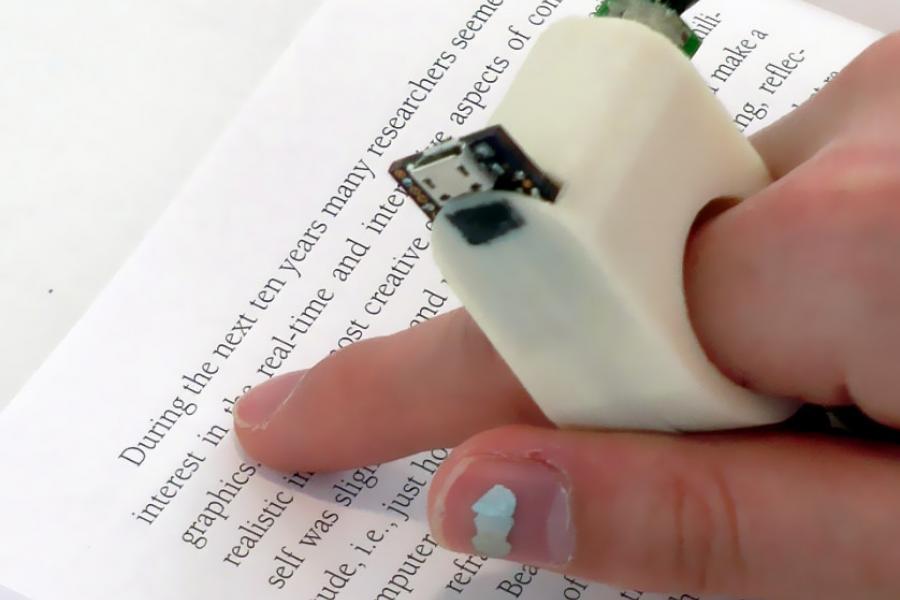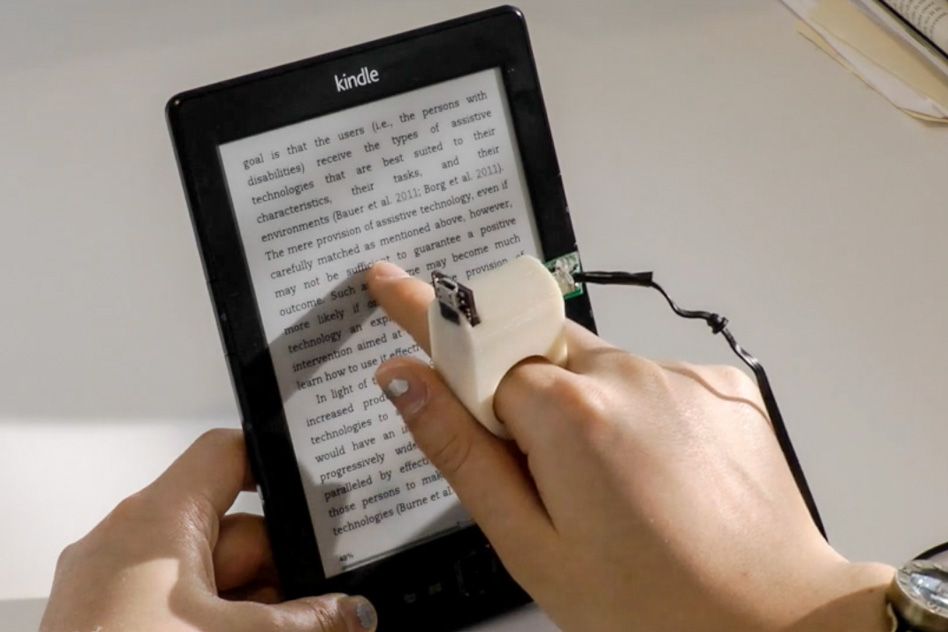Voice-Activated Assistive Devices: Enabling the Visually Impaired
Voice-Activated Assistive Devices: Enabling the Visually Impaired
Blog Article
Discover Innovative Devices Designed for the Visually Damaged
The advancement of ingenious devices for the visually impaired stands for a significant development in access and independence. Technologies such as smart glasses with AI abilities and mobile applications designed to offer acoustic descriptions are improving day-to-day experiences for users.
Smart Glasses for Navigation

Smart glasses developed for navigation are revolutionizing the means visually impaired people connect with their environment. These innovative devices use a mix of video camera innovation, synthetic knowledge, and acoustic feedback to provide real-time details concerning environments. By using obstacle detection systems, smart glasses can signal users to prospective risks, making it possible for much safer mobility in both strange and acquainted setups.
The combination of GPS modern technology better boosts navigating abilities, permitting individuals to receive acoustic instructions as they move. This hands-free method not just fosters freedom yet additionally equips aesthetically impaired individuals to navigate metropolitan landscapes with increased self-confidence. Additionally, many clever glasses are geared up with attributes that recognize spots and street indicators, providing contextual info that enhances the individual experience.
Additionally, the advancement of these devices is continually progressing, with firms functioning to enhance the precision of object recognition and expand the variety of navigational functions. As clever glasses become a lot more economical and available, they hold the prospective to significantly transform day-to-day live for visually damaged customers. Inevitably, these cutting-edge tools represent a critical step toward inclusivity, offering enhanced mobility and a higher feeling of freedom for people browsing the globe around them.

Mobile Apps for Daily Living
Just how can mobile applications enhance the daily lives of visually damaged individuals? Mobile apps are revolutionizing the method aesthetically impaired individuals navigate their atmospheres, take care of everyday tasks, and gain access to info. These applications provide essential assistance via numerous performances, fostering independence and enhancing lifestyle.
A number of innovative mobile apps are made especially for everyday living. As an example, applications like Be My Eyes link aesthetically impaired users with sighted volunteers via video clip phone calls, allowing them to receive real-time aid with jobs such as reading tags or browsing unknown spaces. Seeing AI, created by Microsoft, uses fabricated knowledge to describe environments, checked out text, and recognize objects, properly transforming a smart device into an effective tool for day-to-day assistance.
Furthermore, navigation applications tailored for the visually damaged, such as Aira and BlindSquare, use audio-based directions and environmental information, making it possible for individuals to traverse their surroundings securely and with confidence. Past navigation and instant help, mobile applications also support organization and task administration, with attributes that assist customers establish reminders, develop to-do listings, and track consultations. In recap, mobile applications function as vital resources, empowering visually damaged individuals to lead even more independent and meeting lives.
Wearable Technologies for Assistance
Empowerment through modern technology is increasingly noticeable in the realm of wearable tools developed to aid aesthetically impaired individuals. These ingenious tools integrate perfectly right into life, improving navigating and giving crucial responses to individuals. Clever glasses outfitted with electronic cameras can read and recognize faces text aloud, permitting customers to interact more confidently in social and professional setups.
One more significant improvement is using haptic responses systems in wearable gadgets. These systems use resonances or various other tactile signals to communicate information about the user's setting, such this post as challenges or adjustments in surface, boosting flexibility and safety. Wearable modern technologies likewise include wristbands that link to smart devices, alerting users to notices through subtle vibrations, therefore improving connectivity without dependence on visual signs.
As these innovations remain to progress, they are not just boosting freedom for visually damaged individuals however additionally fostering a greater feeling of addition in culture. By linking the void between difficulties encountered in everyday living and the possibility for freedom, wearable innovations offer as pivotal tools in the pursuit for equal rights and empowerment for those with visual disabilities.
Sound Description Devices
Sound more information description tools play a vital duty in improving ease of access for visually impaired individuals, providing them with the capability to involve with aesthetic media. Screen readers for the blind. These tools supply narrated summaries of key aesthetic components in films, tv programs, and live efficiencies, guaranteeing that users can completely understand the context and feelings shared via visuals
Sound summary can be integrated into various platforms, including streaming solutions, movie theater testings, and live theater. Many popular streaming services currently consist of audio description as an accessibility attribute, permitting audiences to pick it quickly. In enhancement to conventional media, specialized apps additionally exist, offering audio descriptions for art events, galleries, and other social occasions.
The efficiency of audio summary depends upon the ability of the narrators, who have to convey visual details succinctly without diminishing the initial audio. Innovations in this area are likewise leading the way for more personalized experiences, where customers can change the level of detail and pacing according to their choices.
Braille Innovations and Tools
Braille innovations and tools have actually substantially transformed the method visually damaged individuals interact with message and details. Modern advancements have actually brought about the advancement of versatile tools that enhance literacy and self-reliance among customers. Especially, Braille show innovations have actually evolved, permitting dynamic reading experiences. These gadgets convert electronic text into Braille, allowing users to access a large array of details on tablets, smart devices, and computer systems.
Additionally, mobile Braille notetakers integrate typical Braille input with contemporary capabilities, helping with note-taking, scheduling, and paper editing on the move. Smart glasses for the visually impaired. These portable devices usually feature text-to-speech capacities, connecting the void between Braille and auditory information
In enhancement, innovative Braille printers have actually arised, allowing users to produce Braille vision exam near me tags, papers, and educational products efficiently. This ease of access cultivates better engagement in educational and expert atmospheres, ultimately promoting inclusivity.
In addition, research right into wise Braille technologies proceeds to increase. Tools that include synthetic intelligence are being discovered to supply real-time navigating help and contextual details, enhancing the customer experience in varied settings. Overall, these advancements mirror a commitment to encouraging aesthetically impaired individuals via technology, guaranteeing they can easily access and engage with the globe around them.

Conclusion
The improvement of innovative devices for the visually impaired significantly improves independence and high quality of life. Smart glasses, mobile applications, wearable modern technologies, audio summary tools, and Braille technologies jointly encourage people by giving necessary navigating support, environmental awareness, and enhanced reading experiences. These technologies not just foster better inclusion yet additionally promote autonomy in day-to-day tasks, inevitably adding to a more accessible and equitable culture for aesthetically damaged people. Proceeded growth in this area holds guarantee for additional improvements.
As clever glasses come to be more economical and obtainable, they hold the potential to significantly change daily life for visually impaired individuals. Mobile applications are changing the means aesthetically impaired customers navigate their settings, manage everyday tasks, and accessibility details. Applications like Be My Eyes connect aesthetically impaired individuals with sighted volunteers through video telephone calls, enabling them to get real-time support with jobs such as reviewing tags or browsing unfamiliar spaces.Additionally, navigation apps tailored for the visually damaged, such as Aira and BlindSquare, use audio-based directions and environmental information, making it possible for users to traverse their surroundings safely and confidently.The advancement of ingenious devices for the aesthetically impaired substantially boosts self-reliance and quality of life.
Report this page